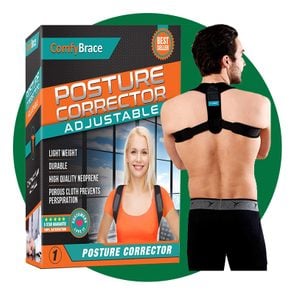I Tried a Back Posture Corrector—Here’s What Happened
Updated: May 10, 2021
I used a back posture corrector for two weeks to improve my posture and alleviate my back pain while sitting. This is what it was like.
Our editors and experts handpick every product we feature. We may earn a commission from your purchases.
Sit straight, shoulders back
Growing up, my mom would tell me to stand tall, sit up straight, shoulders back, chest out, and face forward. After all, this is the key to maintaining good posture and looking confident. And this was before you could wear a discreet back posture corrector. Today, I still heed that advice, but working remotely full-time has led me to slouch more. (Sorry, mom.)
At the beginning of the Covid-19 lockdown, I would find myself hunched over with my back slightly rounded. When I noticed, I would correct myself. But, of course, shortly after I’d reassume the hunched position. As lockdown restrictions were extended, I started to do more sitting than standing (no commute wait times or crowded subways to add to my “stand” goal). Soon, the aggravating lower back pain started to kick in. (Here’s how to improve posture for back pain relief.)
If you use a computer for work, chances are you’re guilty of “sinking into” your work activity and starting to slouch like me.
A small study, published in 2013 in the Journal of Back and Musculoskeletal Rehabilitation, found musculoskeletal pain is common among laptop users. Shoulder pain was the most common (75.7 percent) and elbow pain the least common (37.3 percent). Those who reported the most musculoskeletal pain also used single-strap laptop bags.
The shift from being out and about on a day-to-day basis to leading a sedentary life (minus the at-home workouts and short 10-minute walks) took a toll on my back. Desperate for a quick fix, I decided to do what any millennial would do: I browsed Amazon for a good product. Enter the back posture corrector.
What is a back posture corrector?
A back posture corrector is a wearable device that typically comes in the form of a cross-back brace with adjustable straps, a long line back brace, a lower back belt, or an electronic option with built-in sensors that aim to provide better spinal alignment.
“It can help alleviate muscle tension by reducing pressure on the spine, thereby reducing the amount of strength needed in the muscles to support the spinal column,” says Ingrid Yang, MD, an internal medicine physician in San Diego.
“Back posture correctors sometimes use straps in order to create a force to pull you into what the [manufacturer] perceives as the ‘correct’ posture,” says David Perrotto, a physical therapist at Prehab Network in New York City. They act as constant feedback for how it feels to be in a proper posture position. However, Perrotto cautions, the alignment that the posture correctors bring you into may or may not agree with your body.
He urges you to seek a physical evaluation from a physical therapist first before you buy.
Choosing a back posture corrector
Due to overwhelming curiosity and an Amazon Prime Day deal, I decided to act with haste and get a back posture corrector without consulting a medical professional. (Don’t try this at home.) I opted for a Gearari posture corrector on Amazon that has more than 21,000 reviews and is Amazon’s “#1 Best Seller.”
The major selling point: It was on sale for $7.20 (original price $21.99). Not only was it a good deal, I saw it as an important investment for my health.
Before I started, I read there’s an adjustment period called the “14 Days of Evolution,” according to the manufacturer, during which your posture is expected to improve. For two weeks, you’re supposed to wear it for two hours every day—you can’t wear it for too long in the beginning.
Perrotto agrees you should introduce the back posture corrector gradually. This is so you don’t “introduce too much of a different stimulus to your body, as it can lead to extreme soreness or pain,” he says.
In other words: Your body needs to adjust to it.
His recommendation is to start 30 minutes three times a day on an eight-hour workday. “As long as you do not experience any adverse effects, gradually start to increase the time it’s being used,” Perrotto suggests.
After my back posture corrector arrived, I tried it out for the recommended two weeks. This is what happened.
What it’s like to use a back posture corrector

Week one
The first day using my posture corrector, I was eager and ready to improve my spinal alignment. This back posture corrector was confusing to put on at first. I had to adjust the straps for a few minutes to get it to a setting that was comfortable for me. It almost seemed as if it was my first day of school with a JanSport backpack. The adjustable straps on the back brace are designed so that if you slouch, you’ll feel some tension on your shoulders because the straps tighten.
Ready to start my workday, I made sure my feet were flat on the floor, my chair and computer screen height adjusted, and my hands and arms positioned correctly on the armchair and keyboard.
I was mindful of my posture and ready to reap some benefits. Instead of using it for two hours consecutively, I divided it up into four 30-minute intervals over an eight-hour workday to gradually get my body accustomed to it. (Here are some desk ergonomics to learn.)
After a full workday and taking it off after use, I did notice my concentration and my posture seemed better while wearing the corrector. I was, however, relieved whenever I took it off because it felt like I was wearing a backpack. I felt the straps underneath my armpits.
During the week, I wore the back posture corrector every day and felt different when I wore it versus when I didn’t. I felt I could breathe better. The rest of my body also felt “linear” and alert.
Week two
One week later and I felt the same. I felt great when I wore the posture corrector because I was mindful of my sitting position during the day. I was able to focus more, breathe better, and I also felt my digestion improved after I came back from eating lunch or having a snack. (Here’s what you need to know about sitting disease.)
A plus: My neck and lower back didn’t hurt as much as before. This is likely due to not putting much strain on those muscles. I was relieved for the relief.
However, once I took it off, I slowly started to morph into my standard and “comfortable” slouch position. I would start to notice after working on a story and immediately sit up straight again. But, without the posture corrector, I eventually slumped back down. (Here’s how bad posture can affect your health.)
The truth is the back posture corrector alone is not enough. It’s a temporary solution to a bigger issue. Disappointed, but not surprised, I realized the back posture corrector only works when I wear it. Science agrees.
What the science says
In a small study of 38 healthy overhead athletes (for instance, baseball, volleyball, and tennis players) prone to poor posture, researchers found the use of a compressed shirt and shoulder brace during upper body exercises led to an improvement in shoulder posture and muscle activity. The study was published in the Journal of Athletic Training.
It seems a posture corrector brace does provide the benefit of self-awareness when you wear one, making you more likely to maintain good posture.
The type of back posture corrector experts recommend
When it comes to using back posture correctors, experts vary on what they do and do not recommend.
Preston Brown, a Milwaukee-based board-certified clinical specialist in geriatric physical therapy and owner of Prestige Therapy and Wellness, says you should consider body height and body weight when shopping for a posture corrector. “This is to ensure proper fit and support.”
He adds that it’s important to look for comfort because some posture correctors are a challenge to put on and take off, not to mention uncomfortable to wear. A healthy price range to look for is between $10 to $50, according to Brown. (These are the best posture correctors back experts recommend.)
Meanwhile, Perrotto does not advise the use of these devices. “I don’t use back posture correctors,” he says. “In my clinic, I train people to teach their body to find the position on their own. People need to work on their body and not rely on an outside source. Only if they are forced to sit down for a while will I use something to give them feedback on when they fall into poor posture.”
Dr. Yang agrees, saying she doesn’t believe in back brace use except in an acute situation under the instruction of a doctor. And even then, she says, “I do not recommend the use of back braces for longer than a few days. They are only meant to be helpful in reminding us to maintain good posture.”
If you experience increased pain or discomfort, skin irritation/breakdown, onset of numbness or tingling, or no improvement in posture, Brown advises to stop using immediately.
Ways to improve your posture
If you do not want to opt for a back posture corrector, there’s good news: You can work on improving your posture naturally.
Strength and conditioning exercises
“Conditioning yourself and gradually strengthening the areas that are weak, imbalanced, or overworked with spine-strengthening exercises, is the better way to go,” says Dr. Yang. She suggests doing these exercises when you take your regular breaks throughout the day to stretch and strengthen. “This will help counteract the effects of sitting at a computer for hours at a time,” she says.
Brown also agrees that stretching your lower and upper back will promote good posture and help decrease stress or strain on the entire spine. “Make sure that the exercises you want to do are correct for you and that you are doing them correctly by consulting a physical therapist.” (Here are some recommended upper back stretches you can try out.)
Resistance training
“Movement is the best medicine,” says Perrotto. “Where the work needs to be done is through exercises like mobility and motor training, because your brain and your muscles have to remember how to stay in that position. They need to be trained in that position.” He uses resistance training, motor control training, and yoga to maintain good posture.
“Reverse-posturing”
Reverse-posturing involves going into the opposite position that you spend the most time in. For example, “standing up, bringing your arms overhead, opening up your chest, getting your shoulder blades moving, and getting your hips extending” if you’re sitting most of the day, says Perrotto. He adds that walking is a great counterbalance to sitting.
(Try these chest stretches that can help reverse slouching.)
Set an alarm
You can set an alarm, Perrotto suggests, but he cautions that the success of this depends on how well trained you are. “If you’re disciplined, you can set an alarm for every 20 minutes to bring yourself to a correct posture.” Eventually, the goal is to recognize how long you can hold a good posture.
The takeaway
Back posture correctors are a good start to improving your posture. But I learned that they’re not a permanent fix. When I took mine off, my brain and body lost the feedback it was getting.
Posture correctors “start to speak to your body and brain (about) what a good position is,” Perrotto says. But “a posture position that may be good for you may not be good for another person.”
Also, a back posture corrector won’t be able to teach your nervous system and your brain how to support itself, which is the long-term goal, he says.
All of our experts recommend speaking with a physical therapist or doctor before trying a back posture corrector as a fix to a medical problem.
Next, learn how going braless can affect your balance and posture.






















